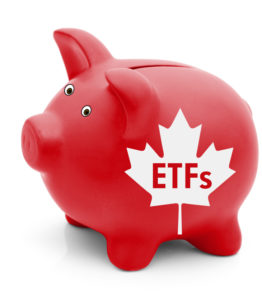
By Dale Roberts, CutTheCrapInvesting
Special to the Financial Independence Hub
I was a panelist for the Best ETFs in Canada. That was an incredible experience and I thank Jonathan Chevreau and MoneySense for the opportunity. When you land on that page you can have a look at the full panelist list, and the bios. It’s an incredible list of ETF experts and of course I am humbled to be included.
From that main landing page simply hit those buttons to have a look at the ‘Best’ Canadian, US, International and Fixed Income offerings. The all-in-one ETFs page includes those popular asset allocation ETFs that deliver ‘complete’ and well diversified and re-balanced portfolios with annual fees in the range of .20%. As Robb Engen of Boomer and Echo offered ‘those ETFs are a game changer’.
Do you really even need to get into the minutia of each individual assets for each region and each fixed income offering? We know that our basic asset allocation; the overall mix of Canadian to US to International stocks plus the ratio of stocks to fixed income will take care of the bulk of our returns and risk characteristics. Many investors are embracing these one ticket solutions, they’ve pulled in considerable assets in quick order. Here’s a little help on how to select the ‘right one’. Please have a read of Which Vanguard All-In-One, One-Ticket Portfolio Should You Invest In?
Vanguard got the nod from the MoneySense panel. That said, the offerings from iShares and BMO are all great. They have some slight differences with respect to asset allocation. Here’s BMO Keeps It Simple With Their One-Ticket Solutions.
But of course the self-directed investor will often want to shape their own portfolio. They may be able to order and arrange assets for greater tax efficiency. We can select ETFs that allow us to avoid US withholding taxes. We can create portfolios with greater growth potential. Many self-directed investors want control.
Not a lot of change, but change is a coming

As Jonathan Chevreau notes in the overview “Despite some major changes in our panel of experts, this year’s ranking has in the main affirmed most of our “All-star” picks from previous years and in particular 2018.” This is plain vanilla, couch potato investing for the most part. It’s supposed to be boring. The lists include broad-based market indices and many core bond offerings. There is nothing ‘too exotic’ going on here. With fees at a rock bottom level, it’s difficult to replace the core large cap or total market index funds.
But what about that change that might be on its way?
Indexing does not have to be plain vanilla. We might be able to arrange our portfolios to deliver greater returns or better risk adjusted returns. Retirees might be able to create a wonderful mix of income and growth that delivers more generous and more reliable retirement funding. Indexing can deliver on that factor-based investing that can include the size premium (small and mid cap and equal weight), lower volatility, value, quality and more. For now, those types of funds are not on the lists but I would not be surprised to see new categories created to cover the spectrum.
I would also like to see REITs and foreign bonds included in the mix.
Where you will see some factor-based funds show up is in the Desert Island Picks. For this category panelists were allowed to pick just one fund. What if you could only hold one fund? We then start to see an eclectic list of picks. Ioulia Tretiakova of PUR Investing selected the BMO Low Volatility Canadian Equity ETF ZLB.
Here’s a chart that suggests we might spice things up in the future. Courtesy of portfoliovisualizer.com, here’s ZLB vs the broad-market XIC, from ZLB inception.
Portfolio 1 is ZLB
Portfolio 2 is XIC
 The notion that we always have to take on greater risk to generate greater returns is one of the greatest misconceptions and misrepresentation in the land of investing. And perhaps index investing and modern portfolio theory is to blame for that.
The notion that we always have to take on greater risk to generate greater returns is one of the greatest misconceptions and misrepresentation in the land of investing. And perhaps index investing and modern portfolio theory is to blame for that.
Ben Felix of PWL Capital chose iShares S&P 600 small cap value fund IJS.
Cameron Passmore of PWL Capital selected iShares Core S&P U.S. Value ETF IUSV.
Mark Yamada of PUR Investing went for the tech-heavy and very growth oriented Nasdaq 100 QQQ, while Yves Rebetez went robo with RBOT, Horizons Robotics and Automation ETF.
On my ETF Model Portfolio page I embrace growth and the size premium with that QQQ and iShares mid cap in the Greater Growth Portfolio. I prefer the mid cap IJH to small cap funds.
Yours truly went the dividend route with the Vanguard Canadian High Dividend Yield VDY. My rationale is that I buy my craft beer in Canadian dollars, I’ll pay for those juicy IPAs with my big juicy Canadian Dividends. Thanks for paying your Bell, Telus or Rogers bill on time.
But perhaps the most sensible Desert Island picks were those One Ticket funds courtesy of Robb Engen and Alan Fustey. It would be hard to argue with them.
Thanks for reading. What do you think of this year’s ‘Best’ ETFs? What’s missing? Should more exotic factor-based and smart beta funds be included?
What is your Desert Island pick?
One of my readers, Bernie, had emailed me to suggest that ZLB was best of breed.
I really liked the addition of the new category “Desert Island Picks”. Awesome selection by Ioulia Tretiakova! IMO BMO’s Low Volatility Canadian Equity ETF (ZLB) is the cream of the crop in the Canadian ETF space.
Questions to Dale cutthecrapinvesting@gmail.com or better yet leave a comment on this post.
 Dale Roberts is the Chief Disruptor at cutthecrapinvesting.com. A former ad guy and investment advisor, Dale now helps Canadians say goodbye to paying some of the highest investment fees in the world. This blog originally appeared on Dale’s site on March 27, 2019 and is republished on the Hub with his permission.
Dale Roberts is the Chief Disruptor at cutthecrapinvesting.com. A former ad guy and investment advisor, Dale now helps Canadians say goodbye to paying some of the highest investment fees in the world. This blog originally appeared on Dale’s site on March 27, 2019 and is republished on the Hub with his permission.
Share this:
- Click to share on X (Opens in new window) X
- Click to share on LinkedIn (Opens in new window) LinkedIn
- Click to share on Facebook (Opens in new window) Facebook
- Click to share on Reddit (Opens in new window) Reddit
- Click to email a link to a friend (Opens in new window) Email
- Click to print (Opens in new window) Print

